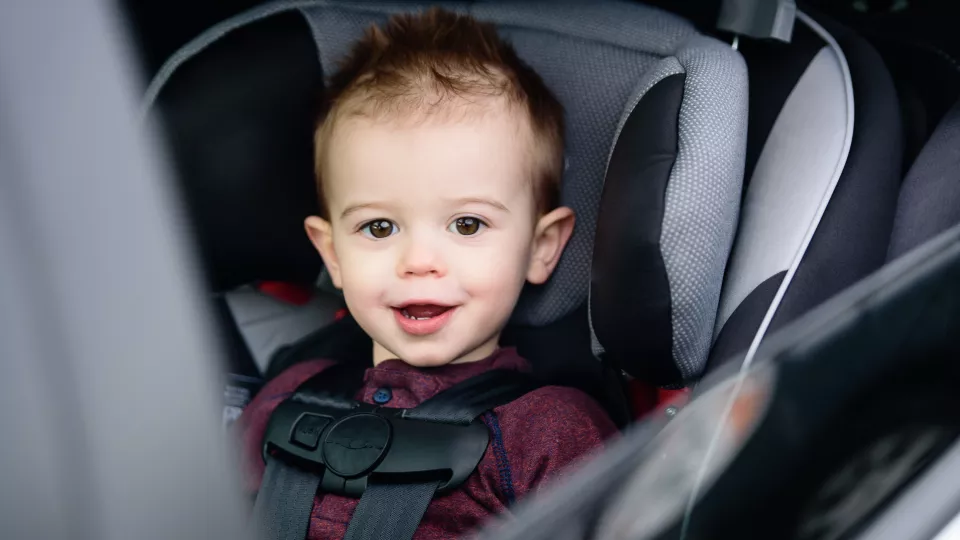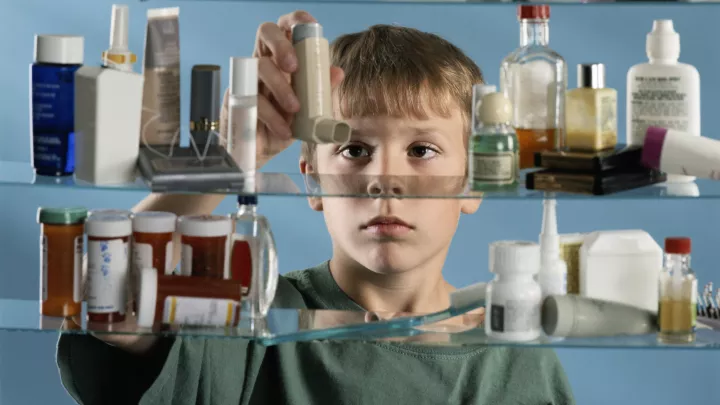
Your car seat should contact your child at five points on the body, including across the chest, as shown here.
Is Your Car Seat a Counterfeit? Here’s How to Know
KEY TAKEAWAYS:
- Car seats sold by online retailers may not have passed U.S. safety standards.
- Signs of a fake include no labels or manuals, and three contact points instead of five.
- Families can check the reliability of their car seat at CHLA’s car seat inspections.
You never forget your first experience with a counterfeit car seat, Helen Arbogast, PhD, MPH, can attest.
“It was like, something is not right with this,” she says.
She sensed it because as Manager of the Injury Prevention Program at Children’s Hospital Los Angeles, Dr. Arbogast oversees the car-seat inspection events that CHLA holds each month. “I've seen car seats from all countries. I've taught child passenger safety abroad. And this didn't look official enough.”
Where were all the manufacturer’s labels pasted onto the seat, affirming the product met federal guidelines? This one, suspiciously, had none.
“Then when I picked it up,” she continues, “it was so lightweight. I was able to push down on the seat and make it fold. I could never do that on an approved, conventional car seat.”
That was in 2021, when counterfeit car seats—a nifty little phrase with potentially lethal consequences—were not a topic of conversation. “We had not started seeing them,” Dr. Arbogast says.
The issue has since emerged, she says, because of consumers’ preference for shopping online, which leaves them vulnerable to mistaking a fake, ill-equipped car seat for a certified one. Below, Dr. Arbogast explains several telltale signs of a counterfeit car seat, how parents can check to see if they own one—and if so, what they can do about it.
Online buyer beware

Families that purchase a car seat over the internet tend to automatically trust that online retailers are performing quality-assurance checks on the car seats sold on their platform and tossing any that aren’t up to code.
In fact, large retail sites that provide space for third-party sellers generally do not vet the merchandise. This allows those vendors to sell products online that may not meet U.S. safety standards—the most important of which, Dr. Arbogast says, is the Federal Motor Vehicle Safety Standard 213 Crash Test, which imposes requirements on products that restrain children in motor vehicles.
“If they're not meeting the requirements, then they are unsafe.” Dr. Arbogast says. So how can parents know if they have one in their possession?
She says to check for the labels that manufacturers paste on the car seat, listing essential information such as the manufacturer's name, the model number, minimums and maximums for weight limit and height—and yellow warning stickers stating that the car seat meets all federal safety standards.
“I've never seen a counterfeit car seat with the appropriate stickers,” Dr. Arbogast says. “I think at some point these manufacturers of counterfeit seats will try to mimic that, but they're not there yet.”
Her next tip is to eyeball the car seat. If it’s a fake, you’ll usually find that it’s made entirely of plastic, which explains its light weight.
Injury Prevention Program Manager Helen Arbogast, PhD, MPHA car seat is like an airbag. Once it has done its job in a collision, it needs to be replaced.
“There are no steel reinforcement pieces, which is what we rely on during a crash, to withstand the crash forces with a child in a vehicle,” Dr. Arbogast says.
Without the proper protection from a car seat, a fatality can result. “I wouldn't put anything short of a play doll inside a counterfeit car seat."
More ways to spot a fake
Dr. Arbogast names several other indicators of a counterfeit car seat. If the seat you’re considering matches any of these characteristics, it’s best to keep looking.
- Too few contact points. If the car seat has a five-point harness system—meaning the seat contacts the child in five places; two straps over the shoulders, two over the legs, and a chest clip—then it was approved in the U.S. If you see a car seat with, say, a three-point harness system, then it may have been approved in Europe, where three contact points are standard, but not here. “So many times they're missing a chest clip,” Dr. Arbogast says.
- No product manuals. Dr. Arbogast says U.S. standards require printed manuals be provided in English and Spanish with every car seat. If yours didn’t come with one, it’s likely a fake.
- Too inexpensive. “If you find a car seat for hundreds of dollars cheaper than the typical price, there's a reason for that,” Dr. Arbogast says. The reason is that it was put together cheaply and thus isn’t worth as much.
If cost is a barrier, Dr. Arbogast says the Injury Prevention Program provides free car seats to families that are eligible for financial assistance, adding that CHLA is the leading distributor of car seats in Los Angeles County.
- Missing registration card. “A brand-new car seat comes with two things: a manual and a registration card,” Dr. Arbogast says. The owner fills out the card and sends it back to the manufacturer, so should anything go wrong, the manufacturer is required by law to either replace the car seat or replace the damaged piece.
“Most counterfeit car seat manufacturers will not provide a registration card because they hope not to hear from you again. You've already purchased from them, and that's it.”
- Sold at a thrift shop or yard sale. Avoid buying a car seat at thrift shops and yard sales. Even if it’s legit, you don’t know what it’s been through. “It could be a legitimate car seat that has already been in a car crash,” Dr. Arbogast says. “A car seat is like an airbag. Once it has done its job in a collision, it needs to be replaced.”
Car seat inspections at CHLA

Dr. Arbogast says her only measure for knowing how many counterfeit car seats are in the community is what she sees at CHLA’s monthly car-seat inspection events. Families drive up with their children in their car seats and technicians certified in child passenger safety have a look.
“We check their installation,” she says. “If corrections are needed, we handle them. If the seat needs to be replaced because it's damaged, has been in a crash, is unfit for the child, or has been recalled, we replace it on-site.”
She encourages families that may now question whether their car seat is a good one to have it checked. “If parents are reading this and thinking, ‘Oh my God, did we buy a counterfeit car seat?’ we'd be happy to help them identify if they have a legitimate car seat or not.”
The first solution is prevention, Dr. Arbogast says. She advises families to shop for a car seat at a brick-and-mortar store so they can handle the item, give it a onceover, and check it for all the signs that it’s the real thing.
She also hopes alerting families that there is this problem jeopardizing their kids’ safety will help to cut the spread of counterfeit car seats that never make it to a CHLA inspection.
“We're not seeing tons of them, but we know they're out there," she says. "I tell people it’s not their fault. There are vendors that target families. But if we can get the word out that this is happening, we'll be doing some good work.”


